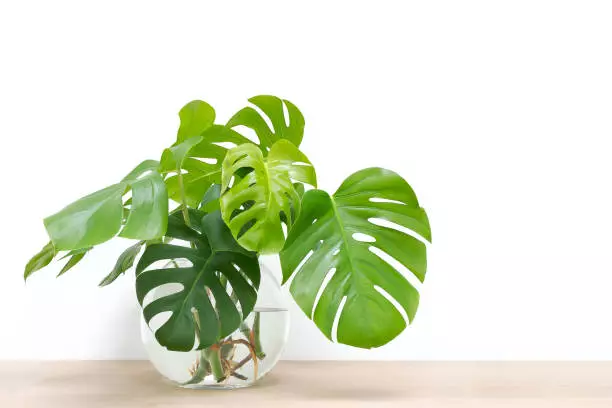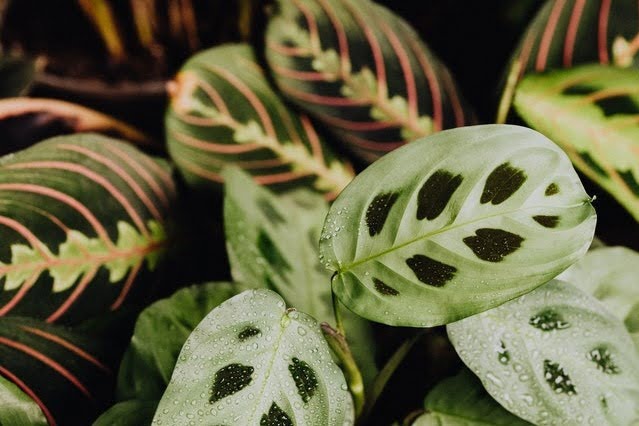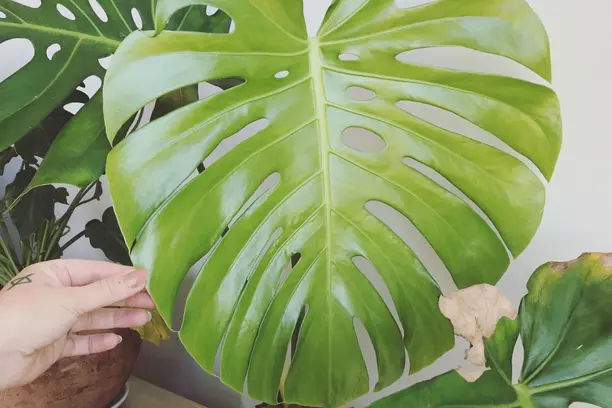The purple color oozes royalty, compassion, calmness, and peace. It is also associated with opulence and beauty. So, by planting trees with purple blooms in your yard, garden, driveway, or archway, you have an assurance of beautiful scenery. But what trees have purple flowers?
Common trees with purple blooms include jacaranda, crape myrtle, eastern redbud tree, purple robe locust, purple orchid, purple leaf plum, Texas mountain laurel, and purple wisteria. When they bloom, these trees produce purple flowers and can make your yard beautiful from spring to summer.
These trees can be giant, dwarf, and twining. Purple flowers bring a whole landscape into life. In addition to the beautiful sceneries, purple flowers also attract pollinators such as bees that play a crucial role in creating and maintaining habitats and ecosystems.
10 Trees with purple flowers
So, let’s see some of the common purple flowering trees that are easy to grow and manage.
1. Jacaranda (mimosifolia)
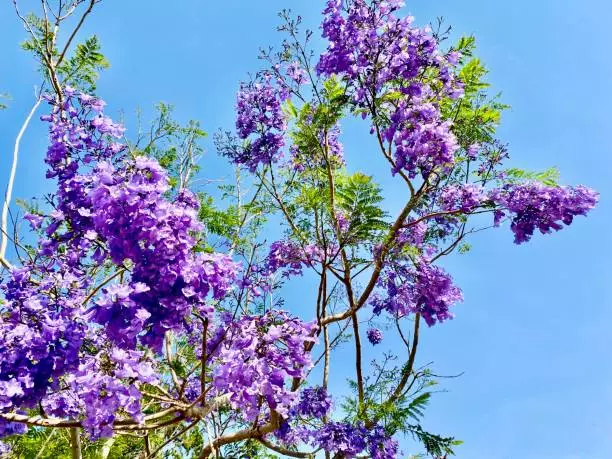
The Jacaranda tree (mimosifolia) originates from South America. Jacaranda is one of the most popular deciduous trees that gardeners love to grow because of its purple lush and feathery appearance.
The love of Jacaranda comes from its conspicuous beautiful and lively purple flowers that blossom in mid to late spring. The beautiful blossoms have a very mild sweet fragrance when plucked or freshly fallen. But, as the flowers drop and rot, they release a pungent, musky smell.
So why do gardeners so much love Jacaranda? Jacaranda trees grow to a height of about 30-50 feet. They are both cold and hot-hardy plants, which quickly adapt to a wide range of weather conditions and soil types. The trees thrive well in well-drained soils and are tolerant to cold temperatures as low as -2.70C. In warm conditions, jacarandas bloom well and for a longer period than in cold regions.
Jacaranda trees provide beautiful purple scenes to your landscape and an exquisite shade. So, to enhance the aesthetics of your landscape, always opt for jacaranda trees.
2. Crape myrtle (Lagerstroemia)
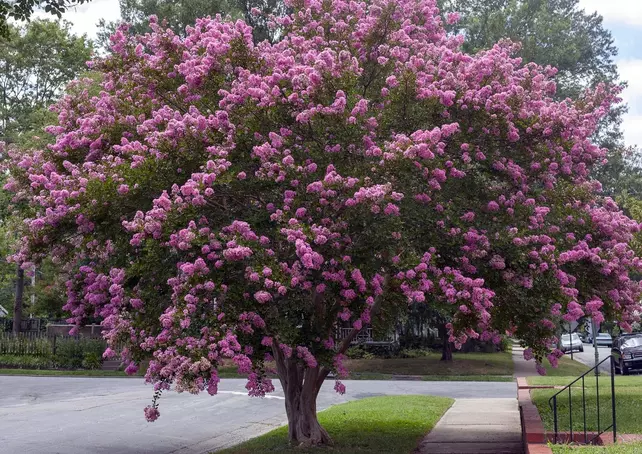
Crape Myrtle is a perennial tree that offers something for every season. The large, bright, and fragrant purple flowers blossom from early summer to late summer for about 70 days.
In spring, crape myrtle provides exquisite shade. In the fall, the leaves turn yellow, orange, or burgundy enhancing the landscape’s aesthetics. The bark also changes from grey in early summer to light pink bark that darkens to reddish-brown. The contrasting color of the flowers and the bark give crape myrtle an outstanding beautiful appearance.
The vibrant purple flowers and the incredible color contrasting effect make crape myrtle a popular choice for beautifying landscapes. Crape Myrtle is a perfect choice for lining fences, driveways, or as a lone ornamental tree or in groupings in the yard.
3. Eastern redbud tree (Cercis Canadensis)
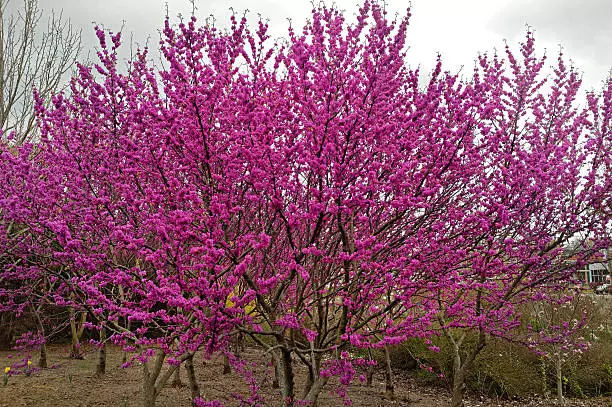
Eastern Redbud originates from Eastern and Central United States. The small to medium-sized with widespread branches produce spectacular and striking purple flowers every spring. The flowers hold in clusters along the branches, and sometimes the trunks cover almost every inch of the tree in light purple flowers. The gorgeous Eastern redbud is a must-have kind of tree in every garden. This is because its leaves turn into striking golden shades in fall.
The Eastern Redbud tree grows in open woodlands, thickets, and along streams. The purple flowering tree grows to about a height of 20-30 feet and thrives well in cold regions. It tolerates temperatures as low as -300C and thrives well in most garden conditions. The purple flowers on the bare branches give it its spectacular appearance. Making Eastern Redbud a perfect choice for a beautiful addition to a garden or yard.
4. Purple robe locust (Robinia pseudoacacia)
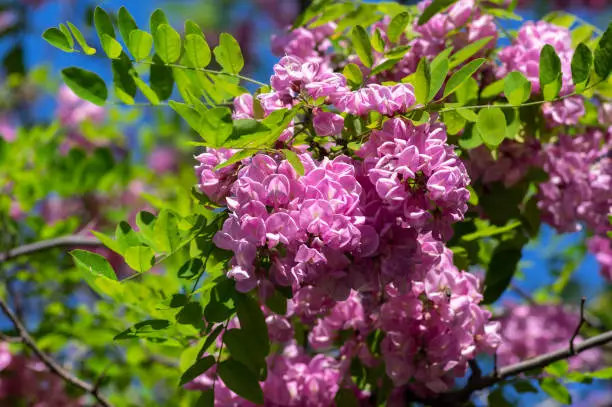
Purple Robe Locust is a cultivar tree of black locusts that originates from North America. The purple flowering grows to a height of 40 feet and 20-35 feet in width. The tree grows into an upright, rounded canopy with irregular branches. In late spring to early fall, the trees produce a 4-8 inch-long dense cluster of fragrant purple flowers. The flowers mature into dark red to black, leathery seed pods.
Purple Lobe Locust thrives in acidic or alkaline, well-drained loamy, clayey, or sandy soils in full or partial sunlight. The cultivar trees are tolerant of drought conditions and saline soils. The rounded canopy trees provide a stunning shade. So, it is an excellent choice for beautifying the yard landscape. The trees need regular pruning of the bristle branches that are susceptible to strong winds.
5. Hibiscus trees (Hibiscus syriacus)
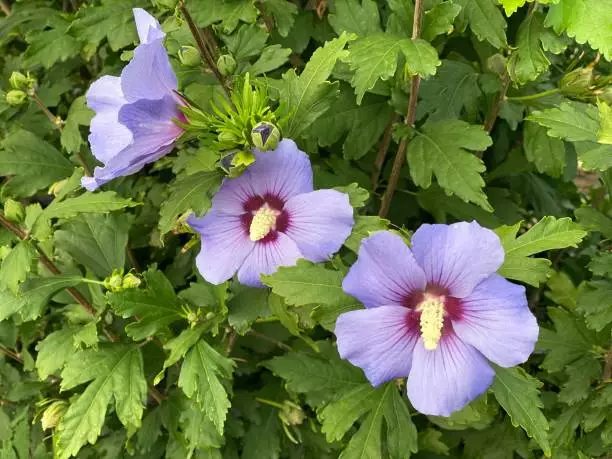
Hibiscus trees are also known as Rose-of-Sharon or Shrub-Althea. Gardeners value the hibiscus trees for their large purple flowers that bloom in summer. The growth rate of hibiscus is slow or moderate. The Rose-of-Sharon tree grows to a height of 8-10 feet and a width of 4-10 feet. Showy purple flowers grow on the widespread open branches.
Hibiscus thrives in well-drained loamy, clayey, or sandy soils in either full or partial sunshine. It is easy to transplant the hibiscus tree because it has several roots located beneath the surface. You can cut the roots into propagates. The Rose-of-Sharon tree is perfect for fencing because of its ability to spread Also, with regular pruning and shaping, it can grow as a stand-alone plant in the yard.
6. Purple orchid tree (Bauhinia variegata)
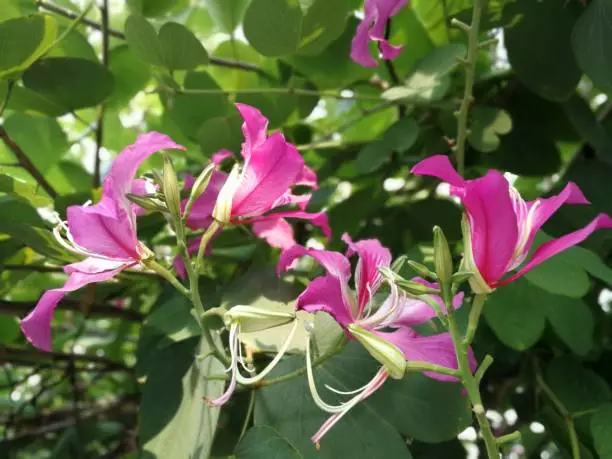
The purple orchid is a fast-growing deciduous plant with slender trunks and widespread drooping branches. The orchid tree grows to about 35 feet both in height and width. The orchid tree produces showy rich purple 5-inch-wide blossoms with a conspicuous fragrance. The light purple flowers bloom in the fall, creating beautiful scenery in the autumn landscape.
It is easy to grow purple orchid trees. The flowers mature into brown seed pods with abundant seeds that grow fast and germinate easily under favorable conditions. The purple orchid tree thrives well in warm regions, in full or partial sun. Orchid trees are tolerant of different types of low alkaline, well-drained loamy, clayey, or sandy soils. The purple orchid tree is drought tolerant, and the flowers bloom well in dry soils.
RELATED: WHAT ARE INDOOR PLANTS THAT GROW THE QUICKEST
Purple orchid trees need regular pruning to relieve the slender and weak trunks of the many drooping branches. The drooping branches make the trunks susceptible to breakage. Pruning also helps keep the garden tidier.
7. Vitex agnus-castus
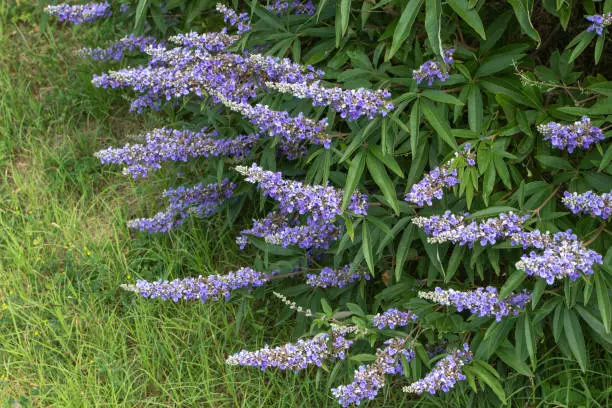
The Vitex tree is also known as the chaste tree. Vitex is a multi-stemmed deciduous tree that grows to about 10-15 feet tall. The chaste trees grow to form symmetrical and well-rounded canopies. Vitex trees stand out because of their showy and strong-scented lilac-purple flowers. The beautiful purple flowers bloom in the summer, beautifying the sunny summer display.
The vitex plants thrive well in harsh conditions and need little care. They grow in well-drained, either acidic or alkaline loamy, clayey or sandy soils in full or partial sun. The tree’s bark is thin and susceptible to the pressure that the drooping branches exert. Thus, regular pruning is vital to avoid stem breakages and maintain a neat well-rounded canopy.
8. Purple wisteria (Wisteria frutescens)
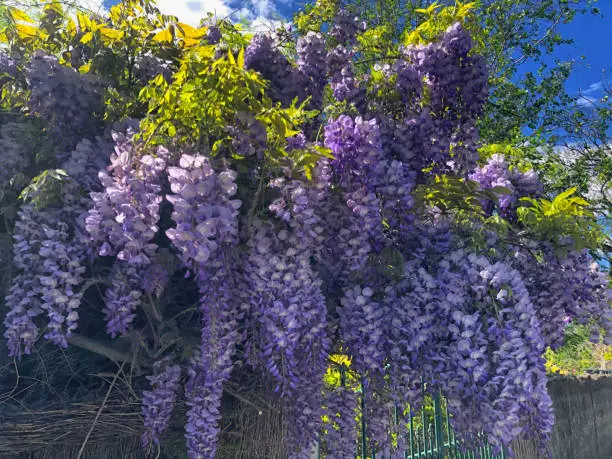
Purple wisteria popularly known as the America wisteria is a high-climbing deciduous woody vine. The woody vine grows to about 20-40 feet tall and twines in a counterclockwise direction. Purple wisteria produces large beautiful strong-scented purple flowers that bloom in spring or early summer.
Purple wisteria is fast-growing and thrives well in slightly acidic, well-draining fertile soil in full sunshine. Do you want to brighten your archway or even your driveway? The hanging purple flowers of the woody vine are your best choice.
It is essential to choose where to plant your purple wisteria carefully. This is because purple wisteria contains toxin substances, wisteria, and lectin. The toxins are harmful to humans, livestock, and pets. Also, do not plant purple wisteria near your home. The notorious vines will find their way into any wall cracks causing significant damage.
9. Lilac (Syringa vulgaris)
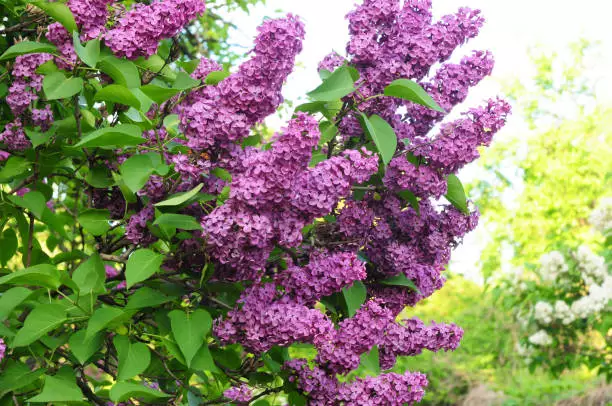
Lilac, popularly known as Common Lilac of the Oleaceae family, originated from the Balkan Peninsula. Lilac is a small multi-stemmed tree that grows approximately 20-25 feet tall. Common Lilac is a very popular eye-catching plant in the yards, parks, and even gardens, because of its attractive, sweet-smelling purple flowers. The fragrant flowers bloom in early summer before the blossoming of other trees.
Common Lilac is the state flower of the state of New Hampshire. This is because its hardiness is symbolic of the “hardy character of the men and women of the New Hampshire State.” Lilac naturally grows on rocky hills, and in the wilderness. Lilac thrives in a wide range of favorable growing conditions and different soil types.
10. Purple Lily Magnolia
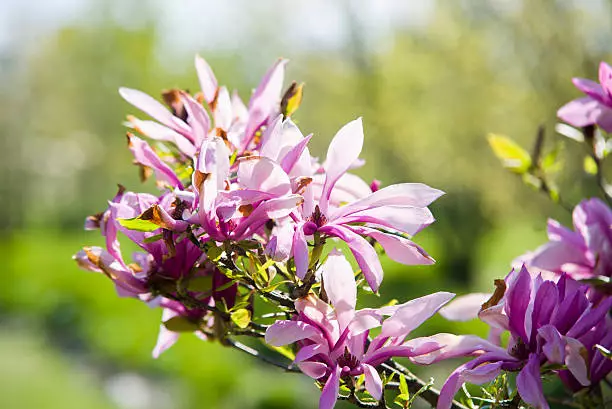
Purple lily magnolia is a slow-growing ornamental shrub that grows to a height of about 6-10 feet. Although it is of diminutive stature, the purple lily magnolia provides striking, beautiful, and architectural scenery in your yard. The dwarf plants produce purple flowers that blossom throughout the spring.
Purple lily magnolia grows well in acidic, well-drained, and fertile soils in full sun. Purple lily magnolia needs regular watering in the early stages. But, as it matures, the watering can be minimized to avoid causing root rot disease.
References:
[1] The University of Utah, Facilities: Purple-robe-locust
[2] The University of Arizona, Campus Arboretum: Jacaranda tree mimosifolia
[3] North Carolina State Unversity, Extension Gardener Wisteria-frutescens
